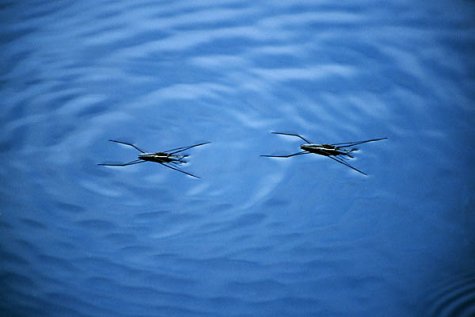Pond skater’s year
Photo: Arne Ader
Translation: Liis
Water skaters
Water skater; water strider Liuskur or vesijooksik Gerris lacustris
There are about twenty species in Estonia but recognizing them needs specialist knowledge. Their exterior is blackish, long and slender. The „water walkers“ support themselves on their hydrophobic (non-wettable) feet on the surface layer of the water. The body too is hydrophobic. The forelegs are used at hunting for prey, the strong middle legs for paddling and the hind legs mostly as rudders. On the underside of the pond skater’s feet is a claw that gives a better foothold in the water surface for pushing, and none will penetrate the water surface.
If you spot one skater there are probably others too nearby and so it is in all the various fresh water bodies and puddles. Live insects are hunted together. Oscillations in the water make the skaters attentive. As stated the prey is gripped with the forefeet, the sharp beak is drilled into the victim and plenty of saliva is injected. This paralyzes the victim, and degrades the insect and after a short while the pond skater sucks its victim dry – only an empty shell remains floating on the surface. As destroyers of mosquito larvae the pond skaters are diligent immediately when a larva settles at the water surface.
The pond skaters spent the winter somewhere near a water body, but on dry land. Flying around in early spring they search out a suitable water body for themselves, and then the pond skaters also lose their wings. In May they mate, and the female lays yellowish oblong eggs by three or four for instance on stones in the water. The lifetime of this generation lasts until autumn. This year’s generation grows wings in September to fly in search of a wintering place. On a clear and calm autumn day the air above some waters can be “thick” with flying pond skaters.









